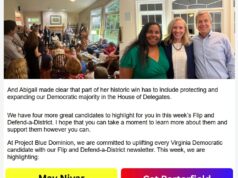Last night, I attended the Virginia bipartisan redistricting commission’s public hearing at George Mason University in Fairfax. A report from WAMU is here, including interviews with blogger Ben Tribbett and Jaime Areizaga-Soto of the Democratic Latino Organization of Virginia (DLOV). After the “fold,” I’ve got some video from last night, including testimony by Tribbett, Areizaga-Soto, and Del. Bob Brink (D-Arlington). Also, State Senator Chap Petersen had a few closing words. Other speakers included representatives from the League of Women Voters, the Virginia Education Association, the Vietnamese-American community, and several others.
My main takeaways from the meeting were threefold. First, it is clear that most speakers were concerned that the redistricting process not be based on incumbent protection or “gerrymandering,” but far more on maintaining cohesive districts with “communities of interest” and within jurisdictional boundaries to the extent possible. Of course, “communities of interest” don’t always coincide with each other or with existing jurisdictional boundaries, which would make redistricting a challenge even if the primary goal weren’t incumbent protection.
more, including videos of Ben Tribbett — check out his theory about why Metro smells like pee, it actually relates to redistricting! — Jaime Areizaga-Soto, and Bob Brink on the “flip”
Second, unfortunately, the unspoken truth of this hearing – the proverbial “elephant in the room” – was that this commission has no power whatsoever. In fact, redistricting is already a “done deal” to a large extent (if not completely), with Republicans dividing up the House of Delegates districts, Democrats (Dick Saslaw, George Barker, etc.) dividing up the State Senate districts, and Republicans (with apparent Democratic acquiescence) dividing up the Congressional districts. In all of those cases, the overwhelmingly most important goal has been incumbent protection, NOT maintaining “communities of interest” or encouraging more minority (e.g., Latino) representation, or preventing “gerrymandering,” or (certainly not) ensuring transparency of the process. In that respect, there is an enormous gap between what I heard in the room last night from citizens and what politicians are doing. Essentially, the entire exercise last night – and as this commission makes its away around Virginia – is a complete charade (not because the members of the commission aren’t dedicated and sincere, but because the politicians want it that way). And we wonder why people are cynical and jaded about politics? Duhhhh.
Third, what really hit me last night is how this seemingly dry, seemingly unimportant, seemingly irrelevant technical process, one that almost nobody pays much attention to, is of enormous importance to our democracy. For instance, the drawing of districts so that the vast majority are not competitive (“incumbent protection”) is highly likely to reduce voter participation and engagement, seriously reducing voter interest and participation. Also, as we’ve seen from various redistricting maps floating around, it’s quite possible to make an 8-3 Democratic or 8-3 Republican Virginia Congressional delegation out of what is essentially a “purple,” 50/50 state. Redistricting also plays a big role in determining which party controls the General Assembly. So, while redistricting might seem boring and dry and irrelevant, it’s actually extremely important. And you can rest assured that one “community of interest” understands that – the politicians!












